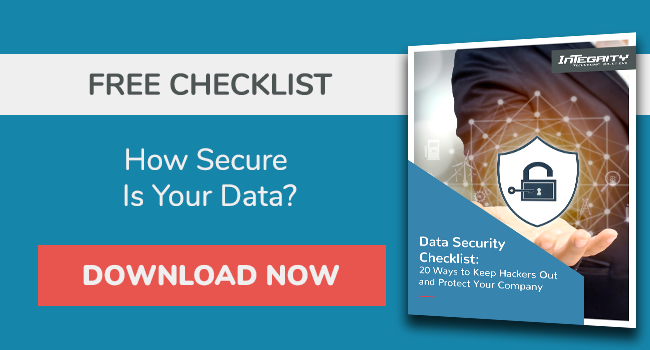4 Growing Cyber Security Threats and How to Plan Against Them

Businesses now face unprecedented cyber security threats and they're growing every day.
As technology has advanced, so has the criminal activity of those looking to exploit it. Your business is at risk and it is up to each employed individual to secure data, protect information, and remain vigilant against increasingly sophisticated threats and scams. While almost everyone can name one or two common threats, few people are aware of all the ways in which cyber criminals are plotting to attack businesses.
SEE ALSO: Use our Disaster Recovery eBook to learn more about protecting your business
Make sure that you're aware of these 4 cyber security threats.
Is your business prepared for these growing data security specters?
1. Phishing Scams
Phishing is one of the scariest threats your business will face. Phishing relies on the trusting nature of your employees, using deceit and fraud to extract personal information. A typical phishing attack works like this: an e-mail is sent to an unsuspecting employee from a criminal posing as a trusted supervisor. The e-mail might look exactly like those from the supervisor and uses a sense of urgency to cause the employee to hand over information without thinking it through. Phishing is so effective because of its simplicity: it's simply posing as someone else and asking for private information. It works because employees trust one another and generally aren't looking for or suspicious of scams. To protect your business, it's important to instill a sense of skepticism in your employees toward odd requests, strange e-mails, and any correspondence that asks for personal data. When building a data security plan, it's even wise to cement policy that no data will be sent like that (and therefore all requests can be assumed malicious) and/or a policy of verification where employees must speak in person to the individual requesting the information, before sending, to ensure that the request is legitimate.
2. Mobile Devices
Employees (and people in general) tend to be more careless with their personal devices than with their work-issued devices. The problem arises when the line becomes blurred. Many workplaces are operating with more modernity - allowing employees to bring their own devices, allowing remote work, and taking a more lax attitude toward access. This isn't inherently a bad thing. But it does open a new world of data security vulnerability. When personal devices are used for work purposes, it exposes that information to a host of new threats that are difficult to account for. If your business allows employees to use personal devices to access private data, do you know if that data is safe? Mobile devices are prone to the same malware, adware, and viruses that your network is - with few of the security features. When building a data security plan, it's important to create tight policy on when, where, and how data can be accessed and transferred. Left unchecked, mobile devices can be the hidden entrance criminals use to steal your business data.
3. Ransomware
Ransomware is a nefarious computer virus that locks down machines in your network, encrypting all data. Ransomware, like Phishing, relies on exploiting human nature and causing panic. Your employee will receive a message after they're locked out that their data is being held captive and that they can have it back... for a price. The criminal hopes that the fear caused by the message will compel the victim to cough up the money without thinking or calling for help. Obviously, criminals should never be trusted and the ransom should never be paid. There's no guarantee that once the money is paid, the unscrupulous criminal will keep his or her word and return the data. The best offense against Ransomware is defense. Make sure that your data security plan accounts for Ransomware and protects against it. Also, educating employees on avoiding suspicious links and downloads will help prevent criminals from gaining access to lock down machines and encrypt data.
4. Internal Breaches
Whether intentional or not, your own employees pose a great risk to your data security. As technology grows and businesses rely more and more on their computer network, the ways in which cyber criminals try to steal information grows alongside it. Employees who aren't educated on cyber security are left open to all kinds of attacks and schemes. This can be something complex (like Phishing, Mobile Device vulnerabilities, or Ransomware mentioned above) or it can be something as simple and innocent as clicking the wrong link, e-mailing unencrypted sensitive information, using public wi-fi while accessing private information, etc. Most of the time, a data breach happens due to carelessness. That's why Security Awareness training is important. However, with more data and more points of access than ever before, it's also possible for a jilted or disgruntled employee to leak information on purpose. A good data security plan needs to account for both.
Be prepared. Know what these threats look like and how you can plan against them.

